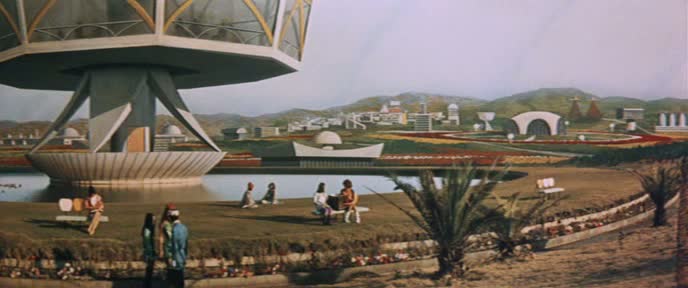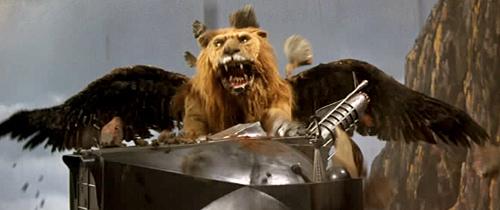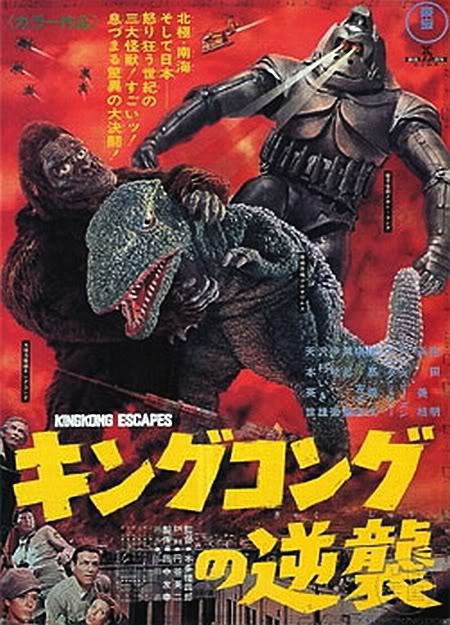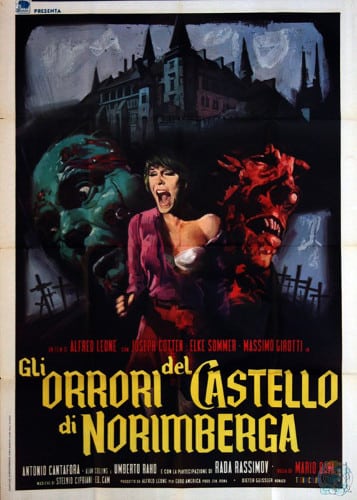Latitude Zero (1969)
Directed by: Ishirô Honda
Written by: Shinichi Sekizawa
Starring: Akira Takarada, Cesar Romero, Joseph Cotten, Magumi Okada
HCF REWIND NO. 135. LATITUDE ZERO AKA IDO ZERO DAISAKUSEN, THE DECISIVE MILITARY BATTLE [USA/Japan 1969]
AVAILABLE ON DVD
RUNNING TIME: 105 min [International version]/99 min [US version]/85 min [Japanese version]
REVIEWED BY: Dr Lenera, Official HCF Critic
East of New Guinea, three scientists – Ken Tashior, Jules Mason and Perry Lawson – are investigating the Cromwell Current, an underwater jet stream running east to west across the Pacific, until an underwater explosion knocks them out. They awake to find themselves aboard the Alpha, a submarine captained by Craig McKenzie. After a run-in with the Black Shark, another underwater craft captained by the villainous Kroiga, the Alpha escapes to McKenzie’s underwater base at Latitude Zero, an undersea Utopia where brilliant scientists are being relocated. However, Kroiga’s boss, the evil Malik, is out to destroy Latitude Zero and ruin McKenzie’s dream of a future society of peace and harmony….
This bonkers adventure movie from Toho studios makes little sense and is sometimes technically rather poor, but it has a goofy charm and an infectious naivety that I wish more films had these days. It’s a bit like King Kong Escapes in tone, generally juvenile but containing the occasional out-of-place more ‘adult’ moment, yet it’s a better film than that; more imaginative and more audacious, even if it doesn’t contain huge monsters. It’s also better acted, and has a conviction about it which just about atones for the really stupid moments and special effects that are certainly not special. I feel that if this had been made by Toho during the early 1960’s it would have been very good indeed. Unfortunately, the Toho of the late 60’s was somewhat different, their films not doing so well and therefore the budgets not so high, while the effects genius that was Eiji Tsuburaya was spending more and more of his time on his TV shows. As it is, the film is a load of fun, but just think at what could have been?!
Latitude Zero suffered especially from its production history. It was based on a 1941 radio serial of the same name by its writer Ted Sherdeman, in collaboration with Warren Lewis and Shinichi Sekizawa. Intended as a medium budget collaboration between Toho and producer Don Sharp, to be shot in English with even the Japanese cast members speaking English, and with five main American stars, the financing from the American side dried up, with the US cast’s checks bouncing just as they had arrived in Japan. Toho picked up the entire budget and producer Tomoyuki Tanaka promised the cast he would pay them in six months, which he did, but the amount of money allotted to the film itself was not nearly enough and corners had to be cut. Joseph Cotten, easily the most prestigious US star to appear in a Toho film, was really ill during shooting due to a liver disease and finished all of his scenes in close-up the day before he was due to be flown home, long-shots later done using a double. The dubbed Japanese version of the film was, unusually, shorter than the US version, by sixteen minutes. It shortens many scenes, giving the film a choppy feel, though the pace is faster. In any case, the ‘International’ version is the one to see. The US release was cut by six minutes by National General Pictures, losing a couple of dialogue scenes. Not a commercial success, it passed into virtual obscurity for many years, almost unseen in and outside Japan because of rights issues, though I distinctly remember it being on UK TV when I was young [though I didn’t get to see it].
Latitude Zero also bares a resemblance to Lost Horizon, and an even more distinct resemblance to a serial I loved as a kid entitled Undersea Kingdom. It really is a potpourri of influences; you can also spot Jules Verne, James Bond,and Toho’s earlier Atragon [the Alpha even gets to fly, though it looks a lot less impressive than the craft in the 1963 movie]. It just about gets away with this by sheer nerve. We get into the action right away, after some rather odd opening narration by Joseph Cotten, with a cool underwater volcano eruption and a battle between the Alpha and the Black Shark. After this, the film does seem to drag its heels a bit as we spend much time wondering around Latitude Zero, but don’t worry, our heroes soon have to undertake a deadly mission, after having taken a ‘Bath of Immunity’ which results in bullets bouncing off their clothing. They have to contend with giant rats, bat men, and eventually Malik and his new, monstrous creation, a sort of Griffin. He ‘makes’ this Griffin by placing the brain of his assistant into the body of a lion, cutting off the wings of a condor and drafting them onto the lion’s back [“Child’s play!” Malik remarks], then enlarging the beast three-fold with his “amplification system”. You see a surprising amount of this, but any horror is undone by the atrocious effects.
Yes, though I often praise the effects in Toho films, whose painstaking, handmade craftsmanship is a dying art, and will say that most of the underwater action in the film looks decent, Latitude Zero is let down by its hilariously bad animal costumes, including a pantomime lion [could they not have obtained a real lion, at least for when it was in a cage?] which, even if only briefly seen, is so laughably bad I cannot believe it was considered okay. The Griffin flies ridiculously stiffly, and along with the disappointing presentation of Latitude Zero itself, which often resorts to photographs of various places and lacks the detail such as miniature vehicles moving around which Tsuburaya often put in, one can only assume that the budget was so ridiculously tight that that’s all they had the time and money to come up with. Especially disappoionting is Malik’s island Blood Rock, which is little more than a load of dull and unconvincing matte paintings of rocks and cliffs. The whole film was shot on sound stages, sometimes giving it a claustrophobic feel. Sloppiness abounds, with even some obvious fluffed lines that are kept in. At one point, Cotten says:”Maybe you’d better test you too” when he’s clearly meant to say:”Maybe we’d better test you too”.
Yet, there is much to like. The costumes are a wild and woolly mix of the medieval [Malik looks like some superhero from about 1400], the futuristic and the 1960’s. The script doesn’t give much detail on things like why McKenzie and Malk are fighting each other, or the relationship between Malik and Kroiga [were they lovers?], but it has an appealing anti-war message which must have appealed greatly to director Ishiro Honda and many who did get to see Latitude Zero upon release, considering the Vietnam war was going on. The Alpha’s weapons are more like defensive devices, while everyone gets along in the McKenzie’s undersea Utopia, where scientists happily toil away on new inventions which may be unleashed onto the rest of the world if and when it deserves it. As usual in a Honda film, the villains more destroy themselves than have the heroes sully their hands in violence. And then there’s the film’s bizarre ending, which is reminiscent of The Wizard Of Oz. Lawson goes back to the surface and encounters doubles of McKenzie, Malik and Tashiro [who had stayed behind]. You could maybe say that the first two are descendants of the virtually ageless McKenzie and Malik of Latitude Zero, but why the hell is Tashiro there? Then again, if you’re going to finish a film like this, better it’s something like Latitude Zero than anything else.
One of the pleasures of Latitude Zero for Toho fans is seeing Akira Takarada speaking English in his own voice, and he’s fine, though others such as Akihiko Hirata are less good. Joseph Cotten really does both look and sound ill throughout, but he gives a strong performance notwithstanding. His wife Patricia Medina also appears as Malik’s wife, and, as for Malik himself, who in one scene watches eels fight in a tank like the way Blofeld watched fish fight in From Russia With Love, he’s played by Cesar Romero in the same delightfully hammy manner he had played the Joker in the 60’s Batman series and film. Unlike Cotten, he really looks like he’s having fun. There’s a very good score by Akira Ifukube that avoids rehashing older material, as he was often doing elsewhere. Though there is some throbbing action music, it’s mostly a subdued, even contemplative effort, with some lovely harpsichord passages for the scenes where we are properly introduced to Latitude Zero. There is no doubt that production problems hurt this movie, and the Toho of the early 60’s would have done the material far better justice, but I still rather like this ridiculous film the way it is.
Rating: 

















Be the first to comment